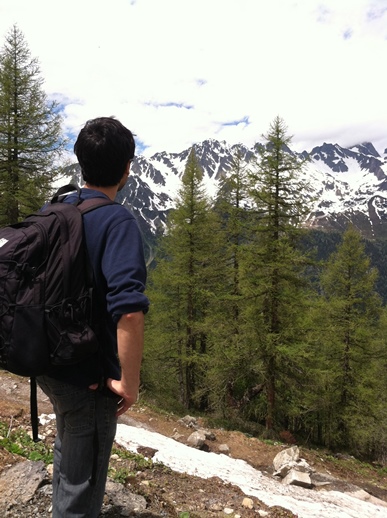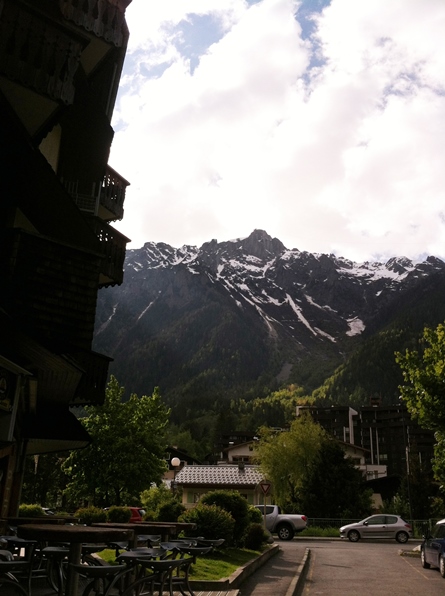The Butler MFA program is growing faster than ever, and in the early summer that growth paid dividends to a handful of students who got to spend three weeks in writerly nirvana, attending intensive workshops in Chamonix, France. Part graduate workshop, part scenic vacation, part mad-science experiment, the first Chamonix Summer Writing Program was a resounding success– so much so that it is being offered again, now a permanent offering to Butler students.
But you absolutely shouldn’t take my word for it. You should, however, take part-time action hero and mountain-summiteer Farhad Anwarzai‘s word for it. On top of pounding out a respectable hillock of pages during his time in France, Farhad carped the diem like there was no tomorrow. After some gentle coaxing, prodding, and friendly threats, I got him to put one of his adventures to paper– so to speak.
I’ve heard rumors and rumblings surrounding your time in Chamonix. Word on the street is that your near-death experience beats the heck out of Jim’s. Care to share?
I am preparing to climb my first mountain in Chamonix. It is a Monday afternoon, the day after my twenty-fifth birthday, and the sun is shining through the clouds that cloak this European commune. The forecast shows warm and short-sleeve worthy temperatures, a good change from the cold and overcast weather of the previous week. Equipped with my new Columbia hiking shoes, a backpack, an emergency sweater, one bottle of water, my camera phone, and a stick I found in the woods, I set off. Compared to the veteran mountaineers, who are equipped with maps, thick fur coats, boots, goggles, trekking sticks and chisels, I am traveling light.
I am supposed to be finishing an assignment for my study abroad prose workshop, a new summer course offered through Butler University’s MFA program. But as I navigate through the forest leading to the mountain, I find myself wondering how I reached the age of twenty-five without having undertaken an adventure of this magnitude. Many factors could be at fault—familial obligations, money, a monkish habit of spending weekends at the library. Yet the root of my idleness, I realize, stems from a fear that I cannot succeed if I waste my time living rather than working.
For once I decide to try something new, to live. I convince myself that this experience will hone my imagination in a way I never thought possible.
There are two paths. The trail in the woods has many twists and turns, and hikers can identify their whereabouts by the markers posted on wooden signs. With waterfalls and countless varieties of flora and fauna, this trail is doubtlessly more scenic and leisurely. The other trail—a rocky dirt route extending upward and following the trajectory of an out-of-order ski lift—is less maintained. There are no markers and few trees on this latter trail. It is one hike up a straight line. I assume this path will take less time. And so, onward ho!
The veteran mountaineers are far ahead of me. But they divert from the path and take a left into the woods. I am now alone. Alone and out of breath. If I slipped and tumbled down the sharp stones, no one would know for a while. So I keep my balance on my stick and progress forward.
Every two hundred meters I take a sip of water, but the supply is already running low. I am sweating a great deal and still not even halfway through the journey. Perhaps I should head back to my studio apartment and complete those last five pages of my short story.
 Eventually, I reach the halfway point. There is a long fence blocking the passage. Both in French and in English, a sign reads: “Danger Beyond This Point! You Are Leaving The Maintained Zone.” Behind me is the entire town of Chamonix. Only halfway up and I am already on top of the world. The winding cobblestone streets, the river at the center of town, the rooftop restaurants, the cafes, the quaint souvenir shops, the discothèques, and the bars outside my studio apartment—I can see it all. After I snap some photos and catch a breather, I climb the fence and journey deeper into the unfamiliar.
Eventually, I reach the halfway point. There is a long fence blocking the passage. Both in French and in English, a sign reads: “Danger Beyond This Point! You Are Leaving The Maintained Zone.” Behind me is the entire town of Chamonix. Only halfway up and I am already on top of the world. The winding cobblestone streets, the river at the center of town, the rooftop restaurants, the cafes, the quaint souvenir shops, the discothèques, and the bars outside my studio apartment—I can see it all. After I snap some photos and catch a breather, I climb the fence and journey deeper into the unfamiliar.
There comes a point where I have to use my hands. I attach my walking stick to a notch in my backpack and climb farther up. But my foot slips on a loose boulder and I save myself by grabbing a thick root. Once I am able to maneuver over the root, I find a rope. The rope is attached to a metal bar that looks like a ballet beam. Farther ahead, there are many more ropes and metal beams. If someone went through the trouble of building a fence at the halfway point, then why would there be artificial helping hands near the top of the mountain? Obviously, the city planners of Chamonix anticipated crazy climbers.
I hoist myself with the ropes and beams. Like a monkey, I scale from one apparatus to the next. The shrubs and flowers are replaced by snow. The higher I get, the more the temperature decreases. By this point I am wearing my emergency sweater, but I regret not bringing my winter coat. And it isn’t helping that I’m incredibly thirsty. Discomforting thoughts aside, however, I grab one last beam and turn over the ledge.
 I have not only journeyed to the top of a mountain, but through the seasons. From summer to winter in a matter of hours. The caps of the mountains are covered with snow. Below, the people of Chamonix are specks. I laugh and nearly cry at the same time.
I have not only journeyed to the top of a mountain, but through the seasons. From summer to winter in a matter of hours. The caps of the mountains are covered with snow. Below, the people of Chamonix are specks. I laugh and nearly cry at the same time.
At the top, it feels like the North Pole. I wander around for a bit, still in shock that the entire planet is in my view. Then I check my phone. It is five p.m. and dinner with the class is at six. The climb up took nearly three hours. And the lift is broken. There is no way I can make it on time.
Another person sits by a ledge. Wearing a black tee shirt with jeans and holding two walking sticks, he looks about my age. I ask him if he speaks English and he says he is British.
Cameron moved to Chamonix for the hiking and skiing. When he isn’t adventuring, he is working at a hotel. He tells me that, due to the recent bad weather, it has taken him three tries to climb the mountain; given that the rain and snow aren’t as dominating now, today is his lucky day. For a moment, both of us stare at the great expanse of our accomplishment. We speak of home, work, schooling, and friends. We spot the wild chamois. Then I check the time. Five-twenty.
The fastest way down, according to Cameron, is to run. “Skiing without the skis,” he says. And sure enough we run. The snow extends to my shins. Cameron maneuvers skillfully with his two walking sticks, while I tumble down and try my best to keep up. We jump over sharp stones and fallen tree trunks. I accelerate to the point where everything around me is a blur. Careful, planned movements no longer guide me; reflexes have taken control.
Cameron cuts a left into in the forest and I follow. We sprint by marker signs, swing through vines, ninja-leap over creeks, and defy gravity. I can no longer feel my legs, yet I keep moving. We pass tourist hikers and veteran mountaineers. We pass the chamois. We pass trees and waterfalls.
And then we make it down.
 At the town square, we shake hands and go our separate ways. With a minute to spare, I walk to Manchu, the restaurant where the class will be having dinner.
At the town square, we shake hands and go our separate ways. With a minute to spare, I walk to Manchu, the restaurant where the class will be having dinner.
Back in my studio apartment, I am getting an avalanche of ideas, words, and images. I start writing a new story. An unfamiliar story. This scares and excites me.
I came to Chamonix to write, to continue a routine that I’d established back home, to work on the same few stories I assured myself were good. But Chamonix broke me of these habits. What started as a workshop became a new chapter in my life as an artist. While it is true that one has to sit at a desk in order to write, and while I don’t recommend anyone risking their life as I so foolishly did, I am convinced that writing and living are synergistic. I cannot live without writing, and I certainly can’t write without living.